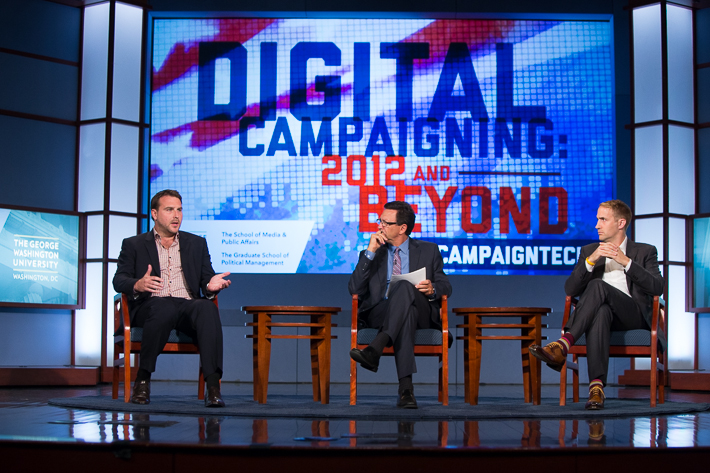The digital world has evolved at warp speed since Obama’s tech-savvy team catapulted the Democratic nominee to victory in 2008, and today’s campaign gurus are still learning how to leverage emerging technology.
During the 2012 presidential election, Zac Moffat and Michael Slaby stood anchored at opposite ends of party lines: Mr. Moffat directed Republican nominee Mitt Romney’s online strategy, while Mr. Slaby served as Barack Obama’s chief integration and innovation officer.
The two digital experts were key parts of dueling campaigns—yet, as they grappled with ways to reach voters and mobilize support, their challenges were often the same.
Before a packed audience on Wednesday at the George Washington University’s Jack Morton Auditorium, Mr. Moffat and Mr. Slaby revisited lessons they learned in 2012 and analyzed how to utilize ever-changing digital tools to steer campaigns in a targeted direction. The Graduate School of Political Management hosted the discussion in conjunction with the School of Media and Public Affairs, whose director Frank Sesno moderated the event.
The ubiquity of social media is one of the biggest game-changers in online campaigns, Mr. Slaby said, changing the ease and accessibility of communication between governments and individuals. Still, every campaign has to remember to focus on engagement, communication and empowering constituents—values that are independent of digital tools.
“Digital is a force multiplier for things a campaign or organization of any type needs to do well—but just because we have developed tools, we don’t suddenly have digital outcomes and goals associated with the organization. We’re still trying to win votes,” he said.
Mr. Moffat added that digital has “shaken up” the way campaigns work, opening doors for younger people to have their voices heard. Its benefits extend to voters who get more information and to candidates who are able to be more transparent with their audience.
In February 2013, Senator Marco Rubio (R-Fla.) awkwardly interrupted his own State of the Union rebuttal by taking a swig of water after 11 minutes of struggling through his speech with a parched throat. Moments after the gaffe, he poked fun at himself by tweeting a playful photo of a water bottle. The “water bottle-gate” incident changed the conversation in a matter of seconds, Mr. Moffat said, showing how social media can give politicians a direct line to voters and allow for a more authentic dialogue.
But digital technology has its setbacks, as the Romney campaign’s failed app Orca proved. Orca was supposed to be a “get-out-the-vote” effort that would capture the amount of casted ballots on Election Day and send analytics back to Romney headquarters. The system experienced technical glitches, and although Mr. Moffat said it collected upwards of 15 million pieces of data, it delivered incomplete and inaccurate information.
The Obama campaign had a similar mishap. Mr. Slaby described how developers had tried to build a similar data collection system that “crashed miserably.”
“It shows just how hard it is to build technology at scale in an organization that’s as messy and moves as fast as political campaigns,” Mr. Slaby said, noting that the process of creating technology is radically different—and more time-consuming—than simply using technology.
Disasters aside, technology has helped in the fundraising department. Both Mr. Slaby and Mr. Moffat have drawn from e-commerce examples to speed up payment processes and encourage donations. During Romney’s campaign, Mr. Moffat leveraged the Square application to allow people to contribute funds via smartphone and collected nearly $1 million in four days. He also praises data modeling for its ability to evaluate donors’ purchasing behavior to find similar supporters.
Mr. Slaby’s best practices include letting voters save credit card information and eliminating barriers to make payments.
“We used to joke that the process should be so easy that if people tripped and hit their head on the computer, they would give us money,” he said.
Both strategists also have also learned to approach traditional media buying with more caution, paying special attention to voters who increasingly get their information from sources other than television and distributing resources more effectively by using data to target specific demographics.
One question came from a student in the audience. She asked if social media engagement surges when candidates share personal anecdotes and details about themselves.
“The media landscape we operate in is driven by platforms designed for humans to have relationships with other humans. The more human we behave in using them, the more effective we can be,” Mr. Slaby said.


